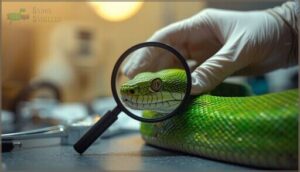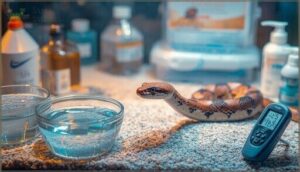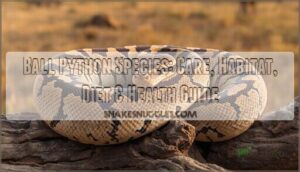This site is supported by our readers. We may earn a commission, at no cost to you, if you purchase through links.
Your snake’s immune system operates on a razor’s edge. A single degree of temperature variation, a missed calcium supplement, or an undetected parasite can trigger a cascade of health complications that manifest weeks later.
Up to 80% of captive reptile disorders stem from preventable husbandry errors—respiratory infections from inadequate heating, metabolic bone disease from vitamin D₃ deficiency below 46 ng/mL, and systemic infections from compromised immunity.
Snake health and disease prevention demands precision: dietary protein at 30–50% dry matter, humidity ranges species-specific to the percentage point, and biosecurity protocols that treat every new acquisition as a potential disease vector. The difference between a thriving snake and a chronic patient often comes down to environmental parameters you can measure and control.
Table Of Contents
Key Takeaways
- Up to 80% of captive snake disorders stem from preventable husbandry errors like improper temperature gradients, humidity imbalances, or nutritional deficiencies—meaning precise environmental control (78–88°F thermal zones, species-specific humidity, dietary protein at 30–50%) directly determines whether your snake thrives or develops chronic illness.
- Early disease detection through behavioral monitoring (lethargy, feeding refusal, respiratory distress) and implementing strict 90-day quarantine protocols for new arrivals can reduce treatment costs by 40% and catch infections like serpentovirus or fungal disease before they become life-threatening.
- Common diseases including respiratory infections, mouth rot, and inclusion body disease often result from compromised immunity triggered by environmental stressors, with mortality rates reaching 75% in untreated cases—making preventive biosecurity and immediate veterinary intervention critical.
- No vaccines exist for pet snakes, so disease prevention relies entirely on maintaining optimal enclosure conditions, species-appropriate nutrition with proper calcium-to-phosphorus ratios, and annual veterinary exams that establish baseline health records and detect problems 60% earlier than symptom-driven visits.
Key Factors in Snake Health
Your snake’s health depends on getting four fundamental care elements right from day one. These factors work together like interlocking pieces—when one falters, the entire system breaks down.
Let’s examine what your snake needs to thrive and how each element protects against disease.
Importance of Proper Nutrition
Nutrition forms the cornerstone of your snake’s health. Without proper nutrition and a species-specific diet, your snake faces metabolic bone disease, immune suppression, and a shortened lifespan. Nutrient balance prevents up to 80% of captive reptile disorders. Proper reptile nutrition management is vital for preventing these issues.
Your feeding strategies must include:
- Dietary protein at 30–50% dry matter
- Calcium requirements of 0.8–1.1%
- Vitamin D₃ above 46 ng/mL
- Dietary supplements for fish-eating species
Snake malnutrition weakens every system, from bone integrity to disease resistance, making preventative measures through reptile care essential.
Hydration and Water Requirements
While proper nutrition builds the foundation, water intake determines whether your snake thrives or suffers. Dehydration effects become critical at 12–18% body mass loss—snakes refuse food, select lower body temperatures, and face metabolic stress.
You’ll need clean water daily, humidity between 50–70% for most species, and bowls large enough for soaking. Drinking behavior indicates hydration thresholds; monitor water quality to prevent bacterial contamination and mineral deficiencies.
Maintaining vital humidity is key for snake health, and understanding humidity control methods is essential for a healthy environment.
Environmental Enrichment and Enclosure Setup
Water sustains your snake, but enclosure conditions shape whether it can actually thrive. Research confirms snakes in enriched environments develop larger brain volumes and solve problems faster than those in barren setups.
You’ll need enclosures matching body length minimum, with climbing structures, multiple hides, and temperature gradients of 78–88°F. Species-specific habitat creation with varied substrates and UV lighting reduces stereotypic behaviors by 40%.
Stress Reduction and Safe Handling
Your enclosure layout means little if handling practices spike cortisol. Studies show cottonmouths with elevated baseline corticosterone strike 75% more often during encounters. Safe handling techniques require hooks, tubes, and lockable containers—training reduces injuries by 20%. Limit handling to essential tasks. Companion presence during procedures cuts stress responses by 60% and shortens recovery time by 4 minutes.
Stress metrics reveal handling realities:
- Routine cage cleaning triggers higher stress than brief manipulation
- Rattlesnakes handled alone rattle 2-3 times more frequently than paired individuals
- Recovery to baseline takes 10-30 minutes depending on stress history
Common Diseases Affecting Snakes
Snakes face several disease threats that can compromise their health and survival if left unaddressed. Understanding these common conditions helps you recognize problems early and respond effectively.
Below are the most frequently encountered diseases in captive snakes and what you need to know about each.
Respiratory Infections
Respiratory infections are among the most serious breathing disorders in captive snakes. Affected animals often exhibit audible wheezing, mucus discharge from the nares, and open-mouth breathing. Without prompt veterinary care, mortality rates can reach 75% in serpentovirus cases. Prevention focuses on infection control, including maintaining proper temperature gradients, ensuring adequate ventilation, and quarantining new arrivals to safeguard the respiratory health of your collection.
| Clinical Signs | Risk Factors | Prevention |
|---|---|---|
| Wheezing, clicking sounds | Poor ventilation | Quarantine protocol |
| Mucus from mouth/nares | Incorrect temperature | Regular enclosure cleaning |
| Open-mouth breathing | High humidity | Stable environmental control |
| Lethargy, pale mucosa | Immunocompromise | Minimize stress factors |
| Neck extension posture | Ammonia buildup | Veterinary wellness checks |
Skin Infections and Fungal Disease
Fungal infections strike vulnerable snakes emerging from brumation, with Ophidiomyces ophiodiicola causing crusted ulcers and thickened skin in roughly 19% of surveyed populations. Snake fungal disease progresses from localized skin lesions to systemic illness without intervention.
- Apply dilute povidone-iodine for mild skin conditions
- Administer voriconazole or itraconazole for persistent fungal infection
- Implement strict infection control and quarantine protocols for disease transmission prevention
Antifungal treatments prevent mortality in late-stage cases.
Internal and External Parasites
Parasites afflict roughly one-quarter of snakes in captivity and wild populations. Internal parasites like nematodes and Cryptosporidium cause weight loss and respiratory distress, while external parasites such as mites spread zoonotic pathogens through direct contact.
Understanding parasite life cycles and transmission routes helps prevent parasitic infection. Anthelmintic therapy using ivermectin or fenbendazole eliminates internal parasites. Ectoparasite control requires environmental sanitation and substrate replacement to break reinfection cycles.
Infectious Stomatitis (Mouth Rot)
Infectious stomatitis—mouth rot—ranks among the most common bacterial infections threatening snake health. Early signs include red spots on the gums, progressing to pus and tissue death. Pseudomonas and other Gram-negative bacterial isolates dominate oral infections.
Recent serpentovirus research detected viral DNA in 80% of sick pythons.
Stomatitis treatment requires antimicrobial therapy, surgical debridement, and correcting husbandry failures. Mouth rot prevention starts with proper nutrition and minimizing stress.
Inclusion Body Disease
Inclusion body disease represents the most devastating viral disease in captive boas and pythons. Reptarenavirus causes progressive neurological damage—stargazing, tremors, poor coordination. A 2020 study found 16.5% prevalence across surveyed snakes. IBD transmission occurs through snake mites and contaminated equipment. Snake quarantine and disease surveillance protect your collection. IBD diagnosis requires blood smears showing characteristic inclusion bodies. No cure exists—euthanasia prevents spread.
Proper snake care includes:
- Strict biosecurity protocols for new arrivals
- Immediate mite treatment and prevention
- Separate feeding tools between enclosures
- Regular health monitoring for early detection
Recognizing Signs of Illness in Snakes
Your snake won’t tell you it’s sick, so you need to become fluent in the subtle language of illness. Early detection often makes the difference between a quick recovery and a life-threatening crisis.
Your snake won’t tell you it’s sick—learn to read the subtle language of illness before it becomes a crisis
Watch for these four critical categories of warning signs that signal your snake needs immediate attention.
Physical Symptoms (Shedding Issues, Weight Loss)
Abnormal shedding patterns signal trouble early. Dysecdysis causes like low humidity or dehydration affect up to 20% of captive snakes, leaving retained skin or eyecaps. Watch for incomplete sheds—they often appear before other snake health issues.
Weight loss exceeding 10% monthly indicates serious malnutrition effects or disease. Skin lesions accompanying shedding issues point to infections or metabolic bone disease requiring immediate intervention.
Behavioral Changes (Lethargy, Lack of Appetite)
Changes in behavior reveal illness faster than physical symptoms. Anorexia in captive snakes can stem from improper temperatures to viral infections, with ball pythons being particularly prone to feeding refusal. Appetite loss exceeding two weeks alongside lethargy demands veterinary evaluation.
- Environmental stressors like inappropriate thermal gradients trigger behavioral disorders within days
- Snake fungal disease reduces activity by 50%, with infected individuals resting in exposed areas
- Systemic infections produce progressive lethargy before other symptoms appear
Address snake stress factors immediately—prolonged anorexia increases infection susceptibility and organ damage.
Respiratory Distress and Discharge
Respiratory infections strike snakes when humidity and temperature drift from species-specific ranges. You’ll notice nasal discharge, open-mouth breathing, and wheezing—clinical signs present in 41.7% of mycoplasma-infected pythons.
Mucous buildup in airways signals bacterial, viral, or fungal disease requiring immediate veterinary attention. Left untreated, respiratory distress progresses to pneumonia with mortality approaching 100% in severe nidovirus outbreaks.
Skin Lesions and Abnormalities
Beyond respiratory signs, watch for skin lesions—red patches, ulcers, or abnormal scale texture. Fungal infections like snake fungal disease affect up to 76% of snakes with confirmed dermatitis, most appearing as ventral surface lesions.
Scale disorders and skin ulcers require antifungal medications; mild dermatitis progresses rapidly without treatment, especially post-hibernation when 41% show “hibernation sores.
Disease Prevention Strategies for Snakes
Preventing disease in snakes requires a proactive approach that meets their biological needs before problems develop. You’ll need to focus on four critical areas: what you feed them, how you maintain their environment, how you protect them from pathogens, and when you seek professional care.
These strategies work together to keep your snake healthy and catch potential issues before they become serious.
Dietary Management and Supplementation
Your snake’s dietary needs form the cornerstone of disease prevention. Feed most species every 1–2 weeks with appropriately sized frozen-thawed prey to establish proper nutrition and nutrient balance. Avoid over-supplementation—excess vitamins during pregnancy increase reproductive failure rates by 39%.
Species-specific feeding strategies matter: calculate meal frequency based on age, activity level, and body condition to support ideal snake health without triggering metabolic complications.
Maintaining Optimal Enclosure Conditions
Control your enclosure’s environment with precision to prevent disease outbreaks. Temperature Control establishes thermal gradients between 75°F cool zones and 80–85°F warm areas, while Humidity Management maintains 60–80% levels critical for shedding cycles. Your Lighting Systems must deliver UVI 2.0–3.0 through proper UV lighting placement:
- Position UVB bulbs 4–6 inches above mesh screening
- Implement 13:11 photoperiods using automated controls
- Select mulch substrates over newspaper for humidity stability
- Perform daily spot cleaning with reptile-safe disinfectants
Ventilation Optimization and strategic Enclosure Design incorporating environmental enrichment complete your disease prevention protocol.
Quarantine and Biosecurity Measures
Before introducing a new snake into your collection, you must implement strict quarantine protocols lasting 90 days. This duration allows serpentovirus and respiratory infections to manifest—critical since 94% of new arrivals can harbor pathogens. Your biosecurity measures require dedicated equipment per animal, separate caretakers, and unidirectional flow patterns that prevent cross-contamination between quarantine and established populations.
| Quarantine Protocol | Implementation |
|---|---|
| Duration | 90-day minimum isolation period |
| Equipment | Dedicated hooks, feeding tools per snake |
| Facility Design | Separate entry/exit with air filtration |
| Personnel Flow | Handle quarantined animals last |
Regular Veterinary Check-Ups
Annually, you should schedule veterinary exams with a reptile veterinarian—biannual visits for juveniles and seniors. Regular health checkups detect disease 60% earlier than symptom-driven appointments, reducing treatment costs by 40%.
Your veterinary consultation benefits include fecal screening, blood work, and husbandry review. These preventive care strategies establish baseline records and cut emergency visits by 25%, making snake health screening essential preventive measures for longevity.
Treatment and Emergency Response
When you suspect your snake is ill, acting quickly can mean the difference between a full recovery and a life-threatening crisis. Knowing how to respond in those first critical hours—and understanding what veterinary treatments are available—gives you the confidence to protect your animal.
Let’s walk through the immediate steps you should take, the medical interventions your vet may recommend, and how to manage both routine illness and true emergencies.
First Steps When Disease is Suspected
When you suspect disease, quick action creates the difference between recovery and tragedy. Immediate care starts with quarantine protocols—isolate your snake within 24 hours using paper substrate and dedicated tools to prevent pathogen spread.
- Document everything: Track weight, appetite, breathing patterns, and visible lesions daily for your veterinarian
- Adjust temperature: Raise enclosure heat to 28–32°C to support immune response during the critical first 48 hours
- Seek expert guidance: Contact your reptile veterinarian immediately—diagnostic testing like PCR and imaging confirms the diagnosis and reduces mortality by 40%
Veterinary Treatment Options (Antibiotics, Antifungals)
Your veterinarian’s treatment arsenal for bacterial infections centers on antibiotics like enrofloxacin, usually administered for 4–10 weeks depending on severity. Antifungal therapy with itraconazole or voriconazole targets fungal infections, though dosing protocols remain challenging due to limited reptile-specific data.
Antibiotic resistance affects 72% of captive snake bacteria—that’s why culture and sensitivity testing guides medication selection and improves treatment outcomes.
Managing Snake Bites and Medical Emergencies
Venomous snake bites demand immediate emergency response—your survival often hinges on swift action. Among 7,000 annual US venomous snakebite victims, only 14% receive antivenom therapy within the critical first hour of hospital arrival.
Essential snakebite first aid steps:
- Immobilize the affected limb and keep it below heart level
- Remove jewelry and tight clothing before swelling begins
- Get to emergency medical care within 4 hours—the median timeframe correlates with better outcomes
Antivenom therapy effectiveness depends on timing. You’ll need urgent resuscitation if shock or respiratory failure develops, with severe neurotoxic cases requiring up to 41.5 vials. Never attempt home treatment or delay medical aftercare—10–44% of rattlesnake victims face lasting injuries without proper intervention.
Long-Term Health Monitoring and Recovery
Post-treatment care extends well beyond the last antibiotic dose. You’ll need veterinary followup at 10–14 day intervals for respiratory cases, with repeat diagnostics confirming radiographic resolution.
Long-term health monitoring includes body condition scoring, behavioral surveillance for hypoactivity or abnormal postures, and health surveillance protocols—annual exams for stable snakes, but 3–6 month intervals during convalescent support.
Recovery protocols demand vigilance, not complacency.
Frequently Asked Questions (FAQs)
Can snakes transmit diseases to humans or pets?
Yes, snakes carry zoonotic diseases like Salmonella, affecting 48% of captive reptiles. Proper handwashing and veterinary guidance reduce parasite transmission risks to humans and household pets by over 80%.
How does brumation affect snake immune system function?
Brumation triggers immune system suppression in snakes, reducing cellular defenses while enhancing humoral immunity.
Seasonal immunity shifts increase fungal infection susceptibility.
Metabolic shifts alter gut microbiota, amplifying disease risks during temperature-dependent dormancy periods.
What role does genetics play in snake disease?
Your snake’s DNA determines its vulnerability to certain infections. Boa constrictors show genetic predisposition to inclusion body disease, while pythons face species-specific risks.
Inbreeding effects reduce genetic diversity, weakening disease resistance across generations.
Are there vaccines available for pet snake diseases?
Currently, no standardized vaccines exist for reptile vaccines or viral diseases in pet snakes. Preventative snake care relies on biosecurity, quarantine, and ideal husbandry rather than experimental immunization, though antivenom research continues advancing snake health care and snake disease diagnosis.
How do you safely transport a sick snake?
Contact your reptile veterinarian before departing.
Use a rigid, escape-proof container with adequate ventilation. Preheat your vehicle, maintain stable temperatures with insulated carriers, and minimize handling time to reduce stress during transport.
Conclusion
Like a medieval alchemist measuring ingredients to the grain, you now hold the formula for snake health and disease prevention. Temperature gradients within two degrees, humidity monitored daily, and calcium-to-phosphorus ratios at 2:1—these aren’t suggestions. They’re requirements.
Your snake’s immune system can’t compensate for guesswork. Every parameter you control directly determines whether your animal thrives or merely survives. Precision isn’t perfectionism here. It’s fundamental medicine.
- https://journals.plos.org/plosone/article?id=10.1371%2Fjournal.pone.0229667
- https://www.sciencedirect.com/science/article/abs/pii/S0304401725000317
- https://phys.org/news/2022-07-potential-welfare-privately-snakes.html
- https://pmc.ncbi.nlm.nih.gov/articles/PMC7543852/
- https://en.wikipedia.org/wiki/Epidemiology_of_snakebites














